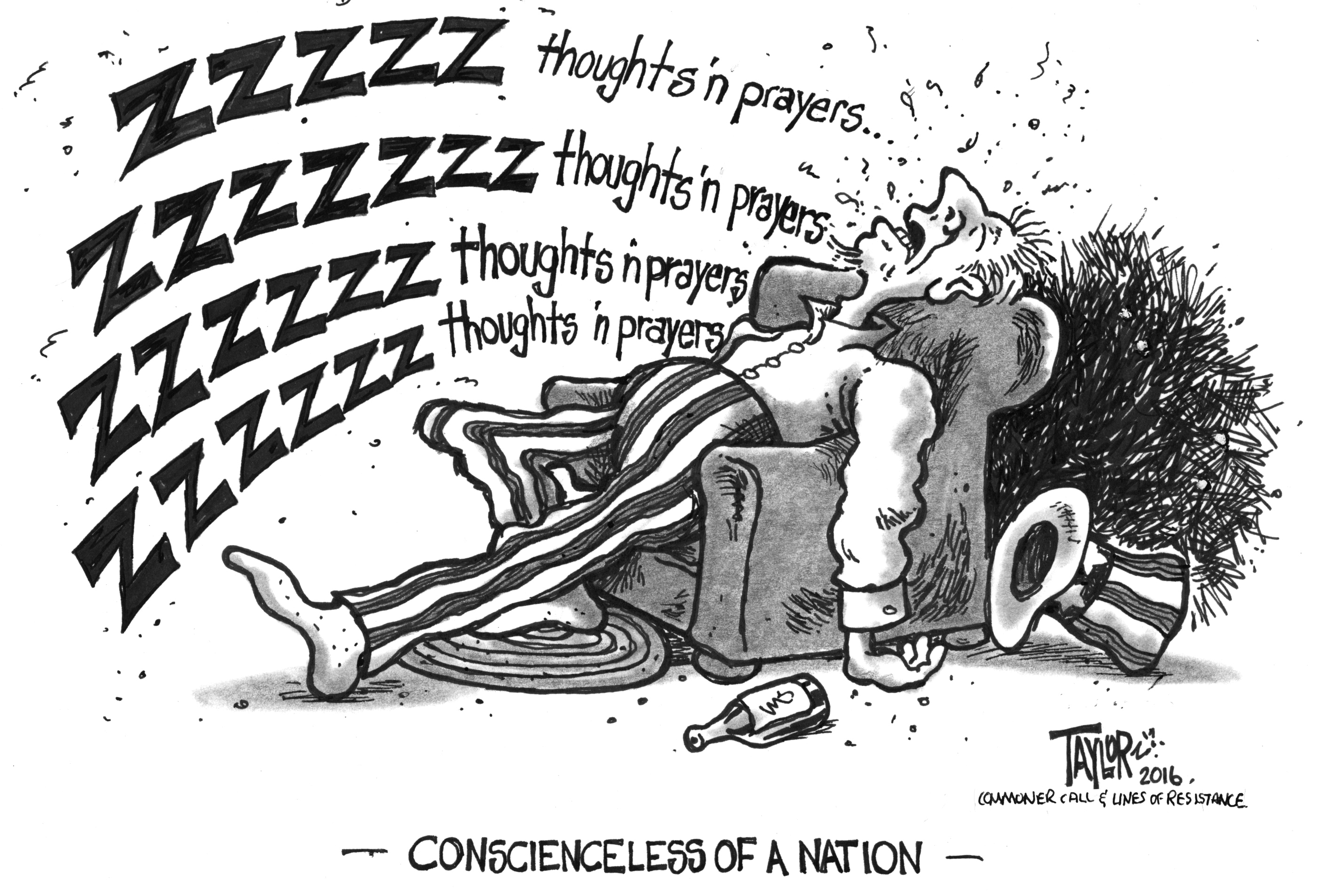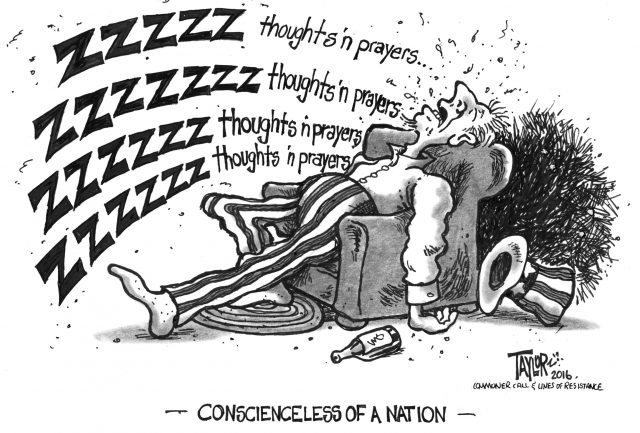Editor’s Note: The Commoner Call runs this cartoon after every headline-grabbing mass shooting (a mass shooting – defined as four or more fatalities – happens daily in the U.S. Most only get local press coverage). Nothing changes but not to worry, the nation’s leaders will keep you in their cynical thoughts ‘n empty prayers if you lose a loved one to a mass shooting. What evil madness! – Mark L. Taylor
*****
At Least 26 Dead In Shooting At Texas Baptist Church
By Nina Golgowski, Paige Lavender & Doha Madani
The HuffPost (11/5/17)
A shooting at a church outside of San Antonio, Texas, on Sunday left at least 26 people dead and 20 others injured.
A man walked into the First Baptist Church in Sutherland Springs at approximately 11:20 a.m. local time after being seen at a local gas station, according to local law enforcement officials. He began shooting what local officials called “a Ruger AR assault-type rifle” inside the church, hitting churchgoers whose ages ranged from 5 to 72 years old, Freeman Martin of the Texas Department of Public Safety said during a press conference Sunday.
Multiple reports have identified the suspect as Devin Patrick Kelley, 26, a white male from outside San Antonio. The sheriff’s office said Kelley was wearing all black clothing and tactical gear when he entered the church. …
*****
Through Carelessness Legal Gun Owners Are Supplying Gangs & Drug Dealers With Firepower
By Laura Morel
The Center for Investigative Reporting (11/1/17)
Teresa Kondek’s doorbell rang, jolting her awake. She peered outside and saw police lights flooding her street. It was 3:11 a.m.
She thought of her husband, a police officer in Tarpon Springs, Florida. He was working the midnight shift and wouldn’t be home for another four hours. Teresa called him. When he didn’t pick up, she opened the front door.
A sergeant she recognized stood outside. Teresa remembered her husband’s words: “If a Tarpon uniform ever comes here, I won’t be home.”
A single gunshot ended Officer Charles Kondek’s life on Dec. 21, 2014.
The weapon: a black .40-caliber Glock, serial number 1ENK082US.
The pistol came from a thriving supply chain that provides criminals in Florida tens of thousands of guns. In 2016 alone, at least one gun was reported stolen, on average, every hour.
In the center console of the Hyundai, they found a Glock 27. Detectives searched its serial number in the Florida Crime Information Center, a statewide database used to identify missing property. It was the gun taken from the Honda in Jacksonville four months earlier.
The Tampa Bay Times and Reveal from The Center for Investigative Reporting spent 10 months examining thousands of law enforcement records to chronicle the extent of the stolen gun problem in the state.
Those guns turn up in the hands of drug dealers and felons. Some wind up killing people.
Since 2007, at least 82,000 guns have been reported stolen and never found. In Tampa Bay alone, at least 9,000 stolen guns are missing.
The Florida Department of Law Enforcement, a public safety agency with statewide jurisdiction, doesn’t keep track of how many stolen guns are recovered. The Times and Reveal obtained data from five law enforcement agencies in Florida and found that between 2014 and 2016, they documented nearly 11,000 stolen guns. Only about 1 in 5 has been recovered.
Car burglaries across the state are driving the epidemic. Many gun owners leave their vehicles unlocked, making it easy for thieves to slip inside. In Jacksonville alone, more than 1,000 firearms were stolen from unsecured cars in total during 2015 and 2016.
Gun stores offer another easy target. Firearms stolen from these businesses during burglaries have more than quadrupled over the last five years, according to federal data, as owners continue to leave large caches of weapons in glass display cases at night.
“That is how the criminals are getting armed,” said Jacksonville Sheriff’s Detective Tom Martin. “They’re not going to go to a store to buy guns. They’re stealing them.”
There are also more guns to steal. In Florida, the number of people carrying guns has surged in the past decade, from 438,864 in 2007 to 1.7 million concealed permit holders this year.
Arming the criminals
Stolen guns enter an illicit market that crosses state lines.
“Basically, the gun owners are arming people we really don’t want to have guns,” said David Hemenway, a Harvard University health policy professor who specializes in gun research.
Four months before Kondek’s murder, two teens crept along driveways on Wind Cave Lane in Jacksonville before dawn, sliding their hands under the handles of cars parked on the quiet street.
They rummaged through glove compartments and consoles, swiping a pair of sunglasses from a Chevrolet Suburban.
In an unlocked 2007 Honda Accord, they found a black pistol. …
(Commoner Call cartoon by Mark L. Taylor, 2016. Open source and free to use with link to www.thecommonercall.org )
*****
Why Is There So Little Research On Guns In The US? Five Questions Answered
By
The Conversation (10/18/17)
When Stephen Paddock opened fire Oct. 1 on concertgoers in Las Vegas, killing 59, the city became the unfortunate host of the deadliest mass shooting in U.S. history. Investigators are still trying to piece together the events that took place that evening, and why.
Like other recent mass shootings, the events in Las Vegas were quickly followed by demands for change to gun control policy.
But which policy do we choose? Following the Las Vegas shooting, debate has focused on bump stocks, accessories that allow a semiautomatic weapon to fire more rapidly. Will restrictions on them help prevent another mass shooting? Is there a better policy option?
Unfortunately, the research we need to answer these questions doesn’t exist – and part of the problem is that the federal government largely doesn’t support it.
Why do we need research about guns?
Gun violence is a public health issue. It’s a leading cause of premature death in the United States, killing more people each year than diseases like HIV, hypertension and viral hepatitis.
While violent crime has generally been on the decline since the mid-1990s, the latest reports from the FBI suggest crime rates may be starting to increase. Gun crime has been a persistent problem. According to the Centers for Disease Control and Prevention, 33,594 individuals were killed by firearms in 2014 alone. That’s only about 200 less than the number of people killed in motor vehicle accidents. In 2015, roughly 85,000 people were injured by firearms, including nearly 10,000 children.
Without increased funding for gun research, it will be extremely difficult for researchers to provide accurate answers to the gun policy questions currently under debate.
In order to prevent gun injuries and deaths, we need accurate information about how they occur and why. While police reports and FBI data can provide some detail, they don’t include the thousands of cases that go unreported each year. Between 2006 and 2010, the Bureau of Justice Statistics estimated that more than a third of victims of crimes involving a firearm did not report the crime to police. The National Crime Victimization Survey, which collects victimization data from about 90,000 households each year, helps to fill in this gap. However, even this survey has its drawbacks. It doesn’t collect data from youth younger than 12, it doesn’t include murder and it doesn’t help us fully understand the offender’s motivations and beliefs.
Social scientists like me need more research in order to get the level of detail we need about gun crime. There’s just one major roadblock: The federal government won’t fund it.
How much federal money is there?
In 1996, Congress passed the Dickey Amendment. The legislation stated that “none of the funds made available for injury prevention and control at the Centers for Disease Control and Prevention may be used to advocate or promote gun control.” While that wording did not ban CDC gun research outright, the legislation was accompanied by a US$2.6 million budget cut. That amount happened to match the amount the CDC had spent on firearms research the previous year. The message was clear. From 1996 to 2013, CDC funding for gun research dropped by 96 percent.
The CDC wasn’t the only federal agency affected. In 2011, Congress added a similar clause to legislation that regulated funding for the National Institutes of Health. However, due to a directive from the Obama administration, the NIH continued to provide funding for gun research. That push faded as the Obama administration left office.
Earlier this year, the NIH discontinued its funding program that specifically focused on firearm violence. While firearms researchers can still apply for funding through more general NIH funding opportunities, critics say that makes funding for gun research less likely.
What prompted these funding restrictions?
The Dickey Amendment was passed after a CDC-funded study led by physician and epidemiologist Arthur Kellerman found that having a gun in the home increased homicide risk. After the results were published, the National Rifle Association pressured lawmakers, arguing that the CDC was inappropriately using its funds to advocate for gun control.
Opposition from the NRA is serious business for lawmakers. The NRA is one of the most powerful special interest lobbying organizations in the U.S. In 2014 alone, the NRA spent more than $3.3 million on lobbying activities – things like meeting with politicians, drafting model legislation and advertising.
The NRA also spends additional millions to advocate or oppose political candidates. In 2016, the NRA spent nearly $20 million on efforts opposing Hillary Clinton and nearly $10 million on efforts supporting Donald Trump.
Not surprisingly, the NRA has successfully blocked gun control legislation in the past, including renewal of the 2004 assault weapons ban.
Can state or private sector dollars fill the gap?
Another potential option for research is to seek out funding from private agencies or philanthropists. But few of these opportunities are available.
According to Garen Wintemute, director of the Violence Prevention Research Program at the University of California, Davis Medical Center, fewer than five private organizations are willing to provide gun research funding.
Private funding is also somewhat risky for researchers. If a funder has a political leaning on gun-related issues, the researcher may be under pressure to produce the “right” results. Even just the implication that a researcher could have a conflict of interest can undermine a study’s results and perceived legitimacy.
State funding may be another option. In 2016, California announced its intent to fund the University of California Firearm Violence Research Center. This is the first time a state has stepped forward to fund a research center focused on guns. California remains the only state to take this step.
Has gun research stopped?
The lack of funding has discouraged firearms research. Many researchers are employed within academia. In this publish-or-perish environment, researchers are under pressure to publish their work in academic journals and fund it through sources beyond their home institution. Without outside funding, their research often isn’t possible. Leading firearms researcher Garen Wintemute says “no more than a dozen active, experienced investigators in the United States have focused their careers primarily on firearm violence.”
Lack of funding leaves some researchers, like myself, limited to small-scale studies with a low budget. The problem with studies like these is that they are often based on samples that are not nationally representative. That means we can’t generalize from the findings or address all the questions we might have.
Without increased funding for gun research, it will be extremely difficult for researchers to provide accurate answers to the gun policy questions currently under debate.


